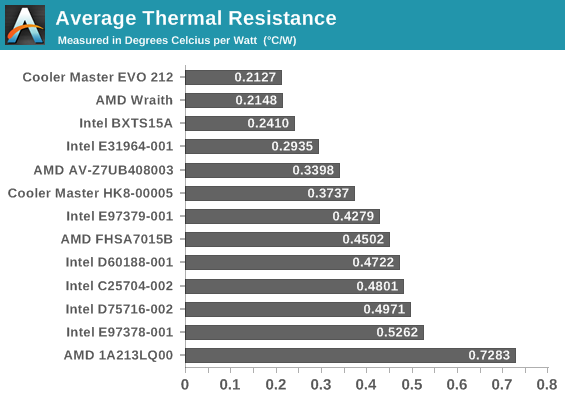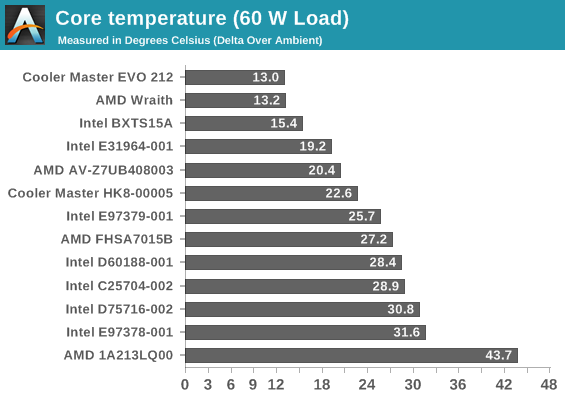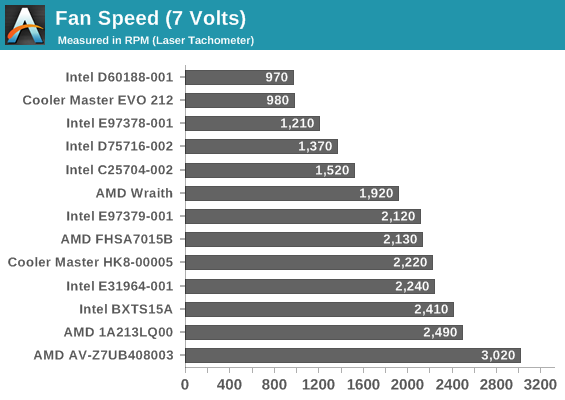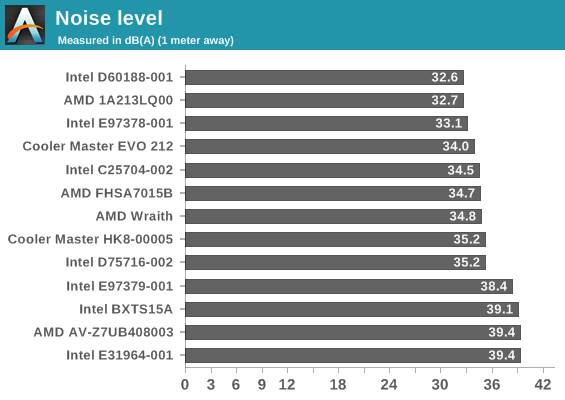Battle of The CPU Stock Coolers! 7x Intel vs 5x AMD, plus an EVO 212
by E. Fylladitakis on July 22, 2016 9:00 AM EST- Posted in
- Cases/Cooling/PSUs
- CPUs
- AMD
- Intel
- Cooler Master
- Cooler
Testing Results, Low Fan Speed (7 Volts)
Intel’s E97379-001 and AMD’s AV-Z7UB408003 coolers are equipped with automatic speed correction circuitry and adjust their speed to the maximum regardless of the input voltage. This renders the majority of basic fan controllers, rheostats and simple fan speed reduction resistors useless. Their speed can only be controlled via a PWM signal from a motherboard. The E97379-001 did have a small speed drop with an input of 6.5V and we included those results, but the AV-Z7UB408003 was rather adamant and devoid of a PWM signal would always automatically correct its speed to 3000 RPM, giving us the exact same performance results as before.

Again, the three most powerful coolers take the top spots at reduced power.

| Core Temperature, Constant Thermal Load (Low Fan Speed) |
Similarly to the 12V results, the EVO, Wraith and BXTS15A are taking the top spots. It's useful to note that EVO 212 and the Wraith are essentially equal as the power increases, with the Wraith being marginally ahead at very high thermal loads.


Putting the two "abnormal" coolers with non-adjustable fan settings aside, the thermal performance of the other coolers decreased almost equally, leaving their standings untouched. The D75716-002 still performs similarly to the C25704-002 and the D60188-001, but the former still is the loudest and the latter still is the quietest of the three. As a matter of fact, the D75716-002 is louder than the C25704-002, even though the fan is slower, hinting that either the fan has a worse engine or the denser fins significantly increased the airflow resistance of the cooler.
We cannot compare the AV-Z7UB408003 cooler to the rest of AMD’s coolers due to the autocorrecting fan. Nevertheless, we can make a useful observation looking at the Cooler Master’s HK8-00005 performance. Despite it has a slightly lower mass compared to that of the FHSA7015B and virtually the same fan, its thermal performance is much better, showcasing how two simple heatpipes can significantly increase the efficiency of a cooler.
Once again, AMD’s Wraith goes directly head to head with Cooler Master’s EVO 212, only this time the Wraith also compares in terms of acoustic comfort. There is virtually no difference between the two coolers in terms of thermal performance and both are equally silent with their fan input voltage reduced down to 7 Volts. The Intel BXTS15A does compare in terms of thermal performance but falls significantly behind when it comes to acoustics, as the cooler remains clearly audible even with its fan’s speed reduced by nearly 40%.










82 Comments
View All Comments
TrantaLocked - Monday, November 27, 2017 - link
Lining up the pins should be super easy just from above, and you can feel and see if the pins have dropped through each hole by paying attention to elevation of each corner of the heatsink.JonnyDough - Monday, August 1, 2016 - link
I have no issue with getting them to work, but they still suck. I like AMD's retention clip, no tools needed. The only issue is when it's in a tight mid-tower case or has a heatsink butted up against it. I don't like needing tools to seat or unseat a heatsink, but if a long standard screwdriver was the only tool needed to make it simpler and quick I'd be all for it. Too many coolers mount one direction (up or rear blowing) and are too difficult to either seat, unseat, or both.mikato - Thursday, July 28, 2016 - link
Yes, those push pins are terrible.FriendlyUser - Friday, July 22, 2016 - link
Excellent, very useful review! People really need to know if they have to budget a cooler or not and what improvement to expect.Thanks!
BrokenCrayons - Friday, July 22, 2016 - link
I recently built a system around an Athlon X4 860K that shipped with AMD's FHSA7015B. I had some reservations about using the boxed cooler, but apathy won out in the end so locked it down over the chip and forgot about it. It does what its supposed to do and at this point, I just can't rationalize going through the trouble of pulling out the thumbscrew on the side panel, removing it, and installing something else. It's not worth my time so for someone like me an OEM boxed cooler is good enough.cowbutt - Friday, July 22, 2016 - link
It'd be interesting to see the results for the copper-cored 150W TDP Intel BXTS13A for socket 2011-3 CPUs (e.g. i7-5xxx). When I got mine about 18 months ago, it was about £15, so about half the price of a Cooler Master Hyper 212 Evo in the UK. If it's anything like the BXTS15A, that seems pretty reasonable for the performance it offers.evilspoons - Friday, July 22, 2016 - link
It's actually remarkable how many similar-but-different coolers Intel has sold. I went through about 15 of them from a pile of stuff at work and only found two that were the same, meaning I had 14 different heatsink/fan combinations. (FWIW some were almost the same but with different fans, but the fans were substantially different in power rating...)Note to future self: if chucking aside Intel stock heatsinks for potential future re-use, label what CPU the came with to save yourself a headache.
dave_the_nerd - Friday, July 22, 2016 - link
Wow. The stock cooler on my i5 really _is_ crap.Ratman6161 - Friday, July 22, 2016 - link
Maybe it isn't. If your system is running fine and you were not having any problems with it, reading an article doesn't suddenly make it crap :)dave_the_nerd - Friday, July 22, 2016 - link
It's been fine for three years. But I can get temps up into the 80s if I'm running Prime95.To futz with it, or not to futz with it. That is the question. :-)